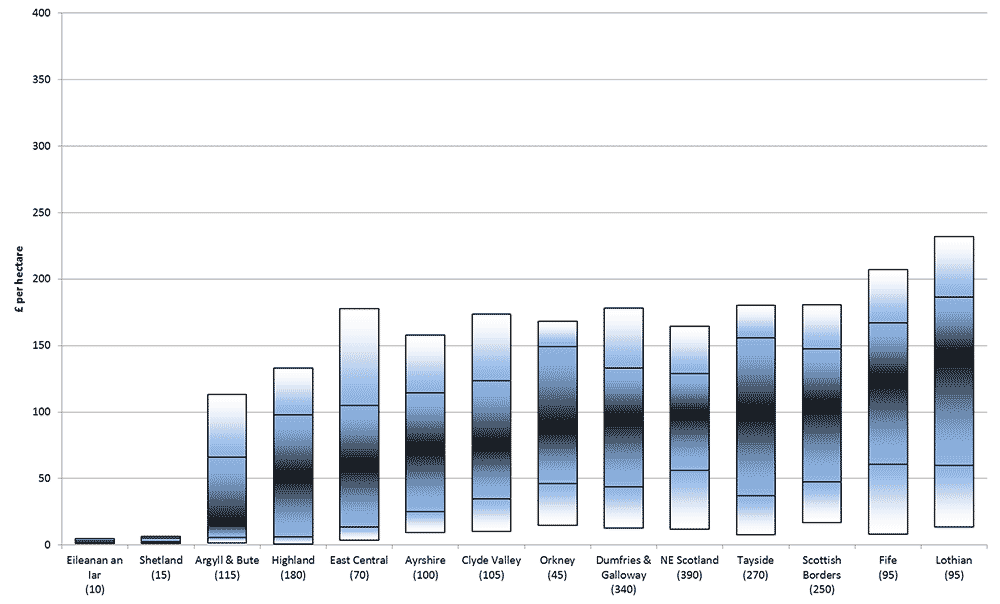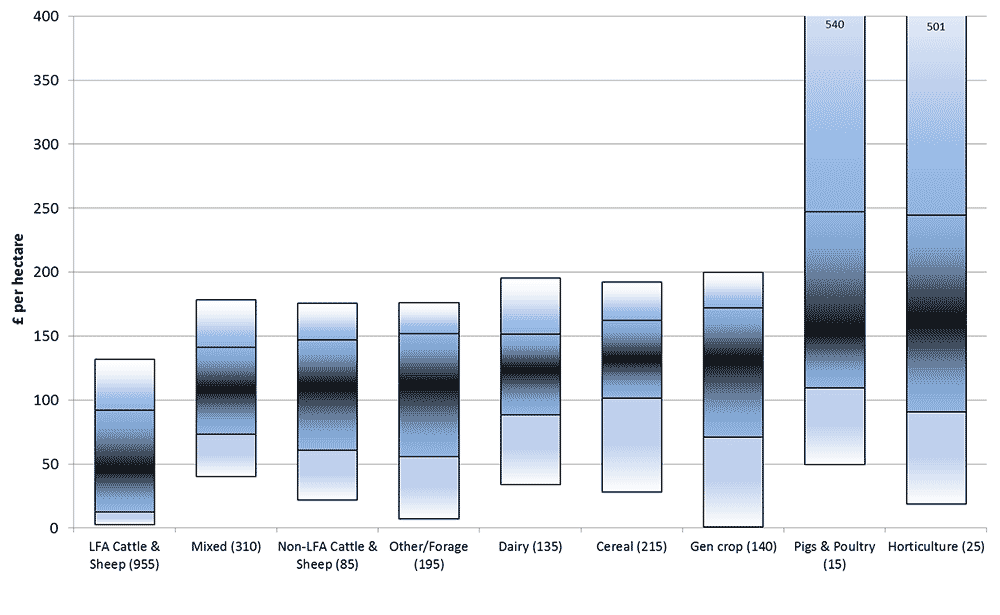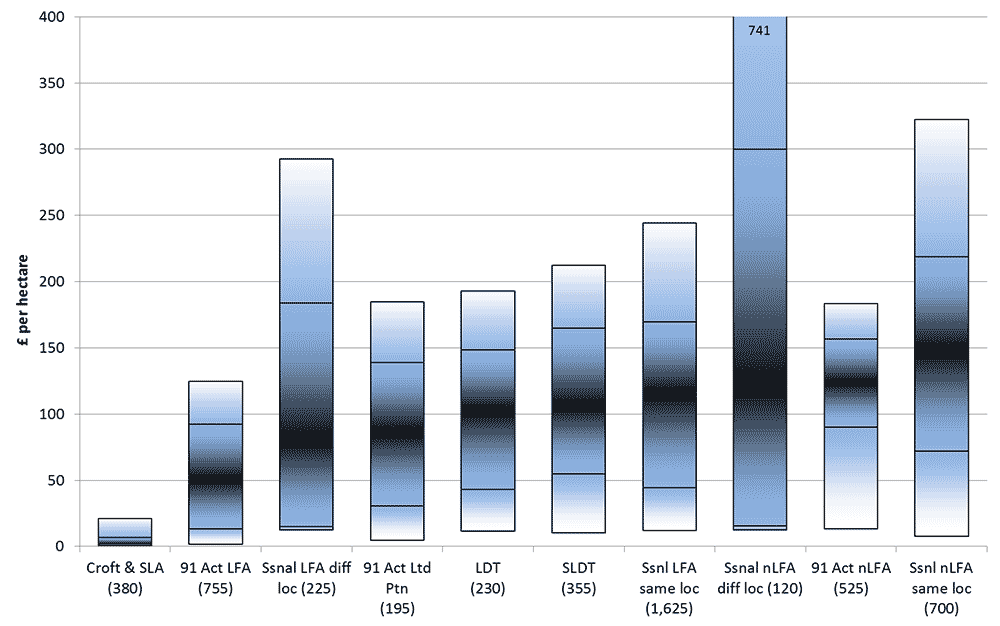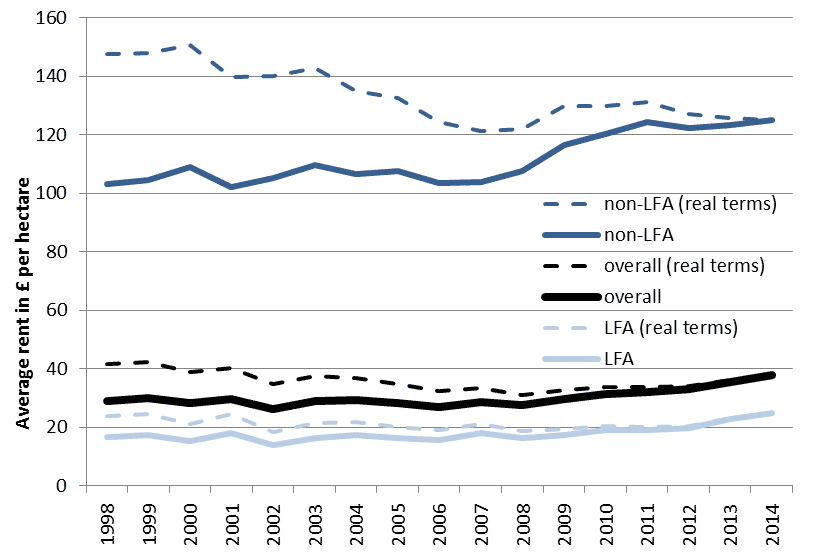Tenanted Agricultural Land in Scotland 2014
Latest statistics of agricultural rents and some data on profitability of tenanted farms
This document is part of a collection
5. Rents
5.1 Background
Rental values for agricultural land will differ depending on a range of variables. The agricultural quality of land varies widely across Scotland, as recognised by the LFA status applied to much of the land. However, within LFA and non-LFA there will be a wide variation. The topology of the land, the remoteness, and the weather are other geographic determinants of a likely rent. Other variables to be considered would be the facilities included in the rent, such as farm-buildings and equipment, and the amount of land rented.
Prices are also likely to be linked to the availability of rented land. It is therefore important to look at the range of rents paid for a given category, rather than just concentrating on an average rate, acknowledging that they cover the variation due to a range of factors.
5.2 Rents paid - methodology
The data on rents paid for tenancies (including crofts) were collected as part of the December Survey of Agriculture and Horticulture. This survey went to about 14,000 holdings, including 4,300 identified as having non-seasonal rented-in land. While the response rate for the non-seasonal rental value questions (2,250 returns, or 52 per cent) was lower than the overall response rate (63 per cent), this dataset is much larger than the previous Tenanted Land Survey [3], allowing more robust analysis of rental values.
Charts 5 to 7 show the range in rents per hectare, by region, farm-type and tenancy type. Please note the following:
- The rent per hectare value relates to the rates for separate arrangements, not the average rent paid on a holding (which may be made up of several different tenancies). The rent per hectare for a tenancy covering a large area of land is treated equally to one covering a small area.
- Rents reported as "in kind" have been excluded from the analysis as we cannot know the value of this payment. About seven per cent of arrangements were reported as being paid "in kind".
- Rents reported as zero have been included.
- Seasonal lets are excluded, other than in chart 7 where they are shown in separate categories.
- The charts do not show the highest and lowest values, but start ten per cent of the way through and end at 90 per cent. So ten per cent of rents are higher than the top of the bar and ten per cent are lower than the bottom of the bar. Then there are lines at the quarter-points (between which half of rents are to be found), and the dark area in the middle is around the median value.
The regions, farm-types and tenancy-types are ordered with the lowest median value to the left going to the most highest on the right. The farm-types used are based on the new standard EU farm-type categories, and are hence not comparable with last year's publication. Due to the small number of pig and poultry holdings it has been necessary to group these.
In interpreting the charts it is important to remember that other variables, perhaps not included in the analysis, will be influencing the range of values reported in some categories more than others.
5.3 Rents paid - findings
Chart 5 shows the range of rents paid in different sub-regions (see table 1 for the make-up of geographies), with the North West reporting the lowest rents. The number of returns in some areas are quite small but they suggest that Eileanan An Iar and Shetland have the lowest rates, even after crofts are excluded from the analysis, explained by their remoteness and quality of land. Highland showed a wider spread of values. Orkney showed higher rents than elsewhere in the North West, more in line with those in the South West, reflecting the fact that location alone does not drive prices, Orkney sustaining strong cattle and cereal sectors.
The South West contained the next lowest group of rents, although with rents in Argyll & Bute being more in line with those in the North West.
Rents in the North East and South East were then generally higher, with Fife and Lothian having the highest rents, with 75 per cent of those sampled paying over £60 per hectare.
Chart 5: Range of rents paid per hectare, by sub-region, 2014/15
Bars show 90 per cent, upper quartile, median, lower quartile and 10 per cent values. The figure below the label shows approximate number of leases for which data was returned. Excludes crofts and seasonal lets. source: Table 6

Chart 6, on the same scale as chart 5 for comparability, also excluding crofts and seasonal lets, shows the rents paid by farm-type [4].
Farm-type is, to a certain extent, determined by the quality of land, and so it would be understandable if some differences appeared between categories in this chart. However, there is little difference between farm types, with the exception of LFA cattle & sheep farms showing predictably lower rents, and the range of rents for horticulture, pigs & poultry extending much higher. The larger values of rent per hectare in these latter categories generally relate to rents of a few thousand pounds for quite small areas, presumably with sheds and glasshouses.
Chart 6: Range of rents paid per hectare, by farm-type, excluding crofts and seasonal lets, 2014/15
Bars show 90 per cent, upper quartile, median, lower quartile and 10 per cent values. The figure below the label shows approximate number of for which data was returned. source: Table 6

Chart 7, on the same scale as charts 5 and 6 for comparability, shows the range of rents by type of tenancy, with seasonal lets split between LFA and non-LFA and whether on a recurring location, and traditional 91 Act tenancies split by LFA and non-LFA. The chart shows the low rents on crofts and the few returns from Small Landholders Act (SLA) tenancies. This was followed by 91 Act tenancies on LFA land. The next cheapest was seasonal lets in LFA areas on differing locations, though the range of these rents included some much higher values. There is little difference in the rates between the three fixed-term arrangements and LFA seasonal lets at the same location on a recurring bases. The most expensive rents were for the non-LFA categories, with the recurring seasonal lets and certain varying-location seasonal lets being the more expensive.
Chart 7: Range of rents paid per hectare, by tenancy-type, 2014/15
Bars show 90 per cent, upper quartile, median, lower quartile and 10 per cent values. The figure below the label shows approximate number of returns. source: Table 6

5.4 Rents paid - overall average per hectare
As detailed in section 5.2, in the above analyses, rent per hectare for a tenancy covering a large area of land is treated equally to one covering a small area, and results from different farm-types are not weighted to make data for each farm-type representative of their size in the industry. However, in order to calculate the overall cost of rent for the estimate of Total Income from Farming, the data have been weighted accordingly to produce a total rent figure. This results in an overall average (including crofts but excluding seasonal lets and rents paid in kind) of £38 per hectare, £25 per hectare for LFA and £125 for non-LFA.
5.5 Historical trend
Chart 12 shows the trend in estimated average rent per hectare from 1998 to 2014.
Prior to 2013, information was collected in the Tenanted Land Survey. This was a stratified sample survey which, in 2012, was sent to 850 holdings with about 600 responses (70 per cent) covering 560 full tenancy arrangements, plus 300 seasonal/short term lets. Since 2013 this has now been replaced by the much larger sample of the December Agricultural Survey. However, the transition between the smaller sample survey, which historically relied on five year average rates, and the new fuller dataset, have led to some changes to methodology, as well as some instability in the historical estimates.
In estimating the average rent per hectare, survey data have been weighted-up so that, for example, the importance given in the calculation to the rent of LFA cereal holdings is in proportion to the actual area of tenancies on LFA cereal holdings in the census. This means that the calculation would not be affected by having too few or too many of a certain type of farm in our survey responses. However, due to the comparatively high non-response rate for this question, there are still some strata where values are based on best estimates.
The chart shows that between 1998 and 2008 there was very little change in the overall average rent paid per hectare (and hence a reduction in real terms, once inflation is taken into account). Since 2008 there has been an above-inflation increase in rent (37 per cent or 21 per cent after accounting for inflation), particularly on LFA land which rose 53 per cent (35 per cent real terms).
Chart 12: Average rent per hectare, 1998 to 2014 source: Table 5

It should be noted that most rents are not reviewed each year; for example 1991 Act tenancies can be reviewed no more than every three years. Hence the overall average increase comprises those with no increase this year and those with increases above six per cent.
Contact
Email: Mal Cooke
There is a problem
Thanks for your feedback